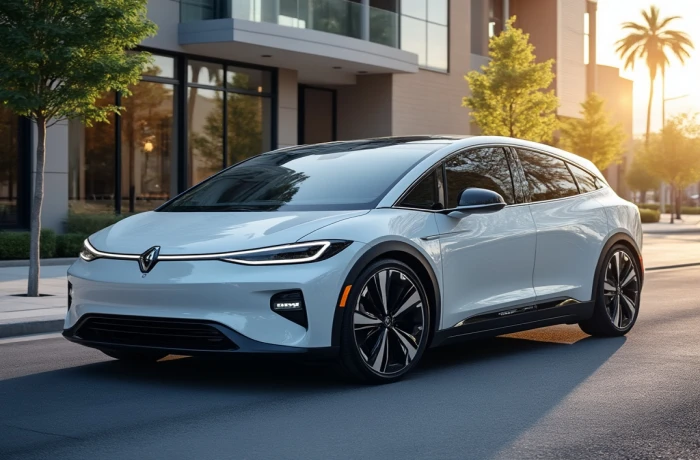Are You Eligible for the 2024 EV Tax Credit Learn More

Lila Claybourne
Oct 29, 2024

Summary:
Overview of the 2024 EV Tax Credit
Income limits and AGI timing strategies for qualification
Point-of-Sale Credit: How to apply the credit at the dealership
Expanded vehicle eligibility table with popular EV models
Partial credit information for vehicles with incomplete battery compliance
Leasing options: Who gets the credit, the dealer or consumer?
How to check battery sourcing compliance
Year-by-year breakdown of battery compliance rules
Non-refundable credit explained with real-world examples
Expanded FAQ section with more specific questions
Conclusion: How AmeriFreight can help ship your new EV
Maximize Your Savings with the 2024 EV Tax Credit
The 2024 EV Tax Credit is a key incentive for those looking to purchase or lease an electric vehicle (EV). However, the eligibility requirements are complex, involving income limits, battery sourcing rules, and vehicle price caps. This comprehensive guide will help you understand how to qualify for the credit, how much you can save, and how to apply it to reduce the purchase price of your new EV.
We’ll also break down leasing options, the point-of-sale credit option, and provide a detailed look at popular EV models to help you decide which vehicle fits your needs and budget.
Eligibility for the 2024 EV Tax Credit
Income Limits for Individuals
To qualify for the 2024 EV tax credit, your Adjusted Gross Income (AGI) must fall within the following thresholds:
$150,000 for single filers
$225,000 for heads of households
$300,000 for joint filers
If your income exceeds these limits, you won't qualify for the credit.
AGI Timing Strategy for Maximum Benefit
Here's a tip: You can qualify for the EV tax credit based on your AGI from either the current year or the previous year—whichever is lower. If your AGI for 2023 is lower than expected for 2024, you may want to purchase your EV early in 2024 to use the 2023 income as your qualification benchmark. This flexibility could help you qualify even if your income increases during the year.
Point-of-Sale Credit: Immediate Savings at the Dealership
Starting in 2024, buyers can use a point-of-sale option to apply the EV tax credit directly at the dealership. Instead of waiting to claim the credit on your tax return, you can transfer the credit to the dealer, effectively reducing the vehicle's purchase price at the time of sale.
How the Point-of-Sale Credit Works:
When you purchase an eligible EV, you can opt to transfer the credit to the dealership.
The dealer applies the credit amount (up to $7,500) to your total purchase price.
You receive an immediate reduction in the vehicle's cost, without waiting until tax season.
This option makes EVs more accessible by lowering the upfront cost. Be sure to ask your dealership if they offer this option when purchasing your vehicle.
Expanded Vehicle Eligibility Table: Popular EV Models
The table below highlights some of the most popular EV models, breaking down their eligibility for the 2024 tax credit based on MSRP and battery compliance.
Note: Battery compliance issues can limit some models to partial credits.
Partial Credit Information: EVs That Don’t Meet All Requirements
Some EVs qualify only for partial credits if they fail to meet the strict battery sourcing and assembly requirements. For example:
Vehicles that don’t meet the full battery component or mineral sourcing rules are eligible for up to $3,750 of the total $7,500 credit.
For vehicles that meet just one of the two battery criteria (sourcing of minerals or components), the credit is split: $3,750 for each qualifying factor.
If your chosen EV doesn’t meet all the requirements, verify with the dealer whether you can claim the full or partial credit. This will help you accurately estimate how much you can save.
Leasing Options: Who Gets the Credit?
If you lease an EV, the leasing company typically claims the EV tax credit rather than you as the consumer. However, many leasing companies pass on the savings in the form of lower monthly lease payments. Before leasing, ask the dealer or leasing company how they handle the credit:
Consumers typically don’t get the credit directly when leasing, but the monthly payments might be lower if the dealer applies the credit.
Ensure the credit has been applied by comparing lease offers for different EV models and trim levels.
How to Check Battery Sourcing Compliance
To qualify for the full credit, your vehicle must meet stringent battery sourcing and assembly rules under the Inflation Reduction Act. Here's how to check if your EV qualifies:
VIN Decoder Tool: Use the Department of Energy’s VIN Decoder Tool to confirm the vehicle’s final assembly location.
Dealer Documentation: Ask your dealer for the vehicle's battery sourcing details. They are required to provide information on where the critical minerals and battery components are sourced.
Free-Trade Agreement List: Visit the U.S. Trade Representative website to see the countries with free-trade agreements that qualify under the battery sourcing rules.
Year-by-Year Battery Compliance Breakdown
Battery compliance requirements increase each year. Here’s how the rules change over time:
2024: At least 40% of critical minerals must come from the U.S. or free-trade agreement countries, and 50% of battery components must be assembled in North America.
2025: Critical mineral sourcing increases to 50%, and battery component assembly rises to 60%.
2026: These thresholds continue to increase annually, making it more challenging for EVs to qualify for the full tax credit unless automakers adjust their supply chains.
Consumers should be aware of these changing requirements and verify their EV’s compliance each year, especially if purchasing a newer model.
Non-Refundable Credit Explained: An Example
The 2024 EV tax credit is non-refundable, which means it can only reduce your tax liability—it won’t result in a refund if your taxes owed are less than the credit amount.
Example:
If you owe $5,000 in federal taxes and your vehicle qualifies for the full $7,500 tax credit, your tax liability will be reduced to zero, but you won’t receive the extra $2,500 as a refund. If your tax liability is $8,000, the $7,500 credit reduces what you owe to just $500.
This makes it essential to evaluate your potential tax liability before purchasing an EV to understand how much benefit you can receive.
Expanded FAQ Section
1. Can I combine state and federal EV incentives? Yes, many states offer additional incentives that can be stacked with the federal tax credit. For example, California’s Clean Vehicle Rebate Program provides up to $2,000 in rebates for eligible vehicles. Check your state’s department of transportation or energy website for local programs.
2. What if my vehicle price is just over the limit? If the MSRP of your EV is even slightly over the price cap—$55,000 for sedans and $80,000 for SUVs, trucks, and vans—you won’t be eligible for the federal credit. Be cautious of additional options or features that may push the price over the limit.
3. Can I claim the EV credit for more than one vehicle? Yes, you can claim the credit for multiple new vehicles in the same year, as long as each qualifies. However, for used EVs, the credit can only be claimed once every three years.
4. Are plug-in hybrids eligible for the tax credit? Some plug-in hybrids are eligible if they meet the minimum battery capacity requirements and final assembly criteria. Check the IRS’s list of eligible vehicles for more details on specific plug-in hybrid models that qualify. Typically, plug-in hybrids with larger battery capacities have a better chance of meeting the requirements for the tax credit.
5. Can I claim the EV tax credit if I purchase a vehicle for my business? Yes, businesses can claim the EV tax credit if they purchase qualifying electric vehicles for commercial use. The eligibility requirements are similar to those for individuals, but businesses should consult a tax professional to ensure they comply with all regulations and maximize their credit.
6. Do I need to apply the point-of-sale option, or can I wait to claim the credit? You have the option to either apply the credit at the point of sale for an immediate reduction in the purchase price or wait to claim the credit when filing your taxes. If you prefer the immediate savings, transferring the credit to the dealer can be a good option. However, if your tax liability is higher and you’d rather claim the credit during tax season, that is still available.
7. How do I know if my leased EV’s tax credit is applied? The tax credit for leased EVs is typically claimed by the leasing company, but many pass the savings on to you via lower monthly payments. Be sure to ask the leasing company or dealership how they apply the tax credit and compare leasing offers to ensure you’re getting the best deal.
Conclusion: Maximize Your EV Savings and Ship Your New Ride with AmeriFreight
The 2024 EV Tax Credit provides a significant opportunity to reduce the cost of purchasing or leasing an electric vehicle, but understanding the complexities of eligibility, battery sourcing, and credit application is crucial. By utilizing the point-of-sale option, keeping track of changing battery compliance rules, and considering partial credit options for vehicles that don’t meet all requirements, you can ensure you make the most of this incentive.
And once you've purchased your EV, you’ll want to ensure safe and affordable transportation, especially if you’re buying from out of state. AmeriFreight offers reliable vehicle shipping services tailored to your needs. Whether you're moving cross-country or just a few states away, get an instant quote here and let AmeriFreight handle your EV shipping with care and expertise.
By following this guide, you can confidently navigate the 2024 EV tax credit, saving money on your vehicle purchase and shipping it safely with AmeriFreight.
Related Posts
















